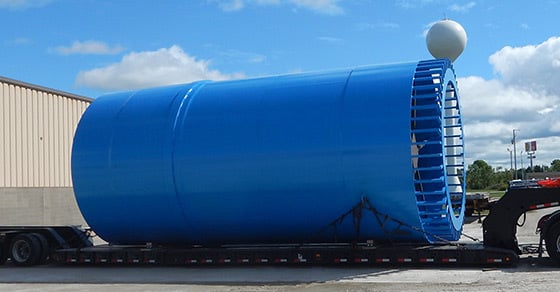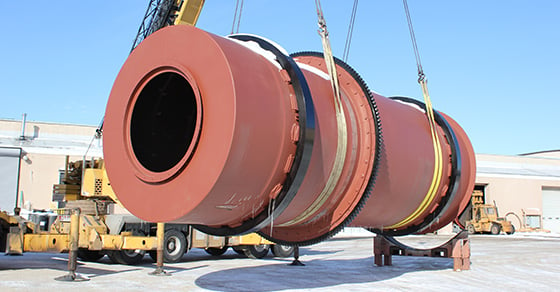The granulation drum, or granulator, is a diverse processing tool used throughout various industries to produce a granular product via wet granulation (also known as non-pressure, tumble-growth, or agitation agglomeration).
The design of a commercial-scale granulation drum must take several factors into consideration in order to yield an efficient, reliable granulator that can produce a product of the desired quality. In addition to the many process parameters that influence granulator design, several characteristics of the material to be processed also play an influential role, impacting bearing and drive components, materials of construction, sizing, and more.
The most influential material characteristics in granulator design are outlined here.

FEECO Granulation Drum with trommel screen
Bulk Density
Bulk density is a significant factor in granulation drum sizing, as it determines the volumetric throughput. Both raw material feedstock and desired bulk density must be considered during the sizing process, since the granulator must be able to accommodate both.
The volumetric throughput, or the volume of the material at the desired capacity, represents the load placed on the granulation drum, and therefore, how much energy will be required. All components of the granulation drum will be selected and designed based on this operational load.
Moisture Content
Moisture content of the feedstock (inlet moisture) is also a critical consideration in granulator sizing and design. As with other wet granulation processes, optimal granulation occurs within a precise range of moisture that is specific to each material. Materials that fall outside of the defined moisture range are not likely to granulate at all, or will yield poor-quality granules.
The moisture content of the incoming material will determine how much liquid binder will be needed, and often, at what point(s) in the drum the binder should be distributed. Material feedstock that is over the threshold at which granulation occurs will require a drying step to bring the moisture content down prior to the granulator.
Moisture content of the material also affects how the bed tumbles, and may necessitate the use of tumbling flights, which work to turn over the bed and improve agitation and granulation.
The moisture of the discharged product (outlet moisture), often referred to as green or wet pellets, must also be considered. Achieving a desired outlet moisture helps to keep granules intact throughout processing and transfer points prior to final drying. This attribute is referred to as green strength.
The difference between the inlet and outlet moisture also determines how much binder will be needed to achieve the desired outlet moisture.
Particle Size Distribution
Both desired and incoming particle size distribution must be factored into granulator design:
Desired Particle Size Distribution
Desired end product size is controlled through retention time, or the amount of time at which the material is processed in the drum. Retention time, in turn, is largely controlled through drum sizing; the larger the desired granule, the more retention time that will be required, and the larger the drum must be to allow for that retention time.
Incoming Particle Size Distribution
Though it does not necessarily impact the drum design itself, the particle size distribution of the feed material is crucial to making a good, strong product, and will influence the design of the system in general.
Incoming particles need to be below the desired end product size, with a good cross section of particles within the defined range that is optimal for granulation. A good cross section of particle size promotes effective agglomeration by allowing smaller particles to fill in the spaces between larger ones and create a strong green product.
Particles over the desired size range will require some form of size reduction as a preconditioning step before the granulator.
Chemical Composition
A material’s chemical composition is also an important consideration in granulation drum design. Depending on the chemical makeup of a given material, the material may pose corrosion, abrasion, sticking, or other issues. These issues are typically addressed through careful selection of the materials of construction, as well as the use of liners or other internals.
Temperature
While the incoming material temperature is not always a factor in granulator design, it is a necessary consideration when it has the potential to impact the chemical or physical nature of the material. If the temperature is above the boiling point of water, more water/liquid binder will be required because of evaporation.
Conclusion
Granulation drums are an integral processing component in many industries. A wide range of material characteristics impact granulator sizing and design, and must be considered as part of the design process. Factors such as bulk density, particle size distribution, moisture content, and more, are all highly influential in granulator design.
FEECO is a leading provider of the world’s most reputable granulation drums. All FEECO granulators are designed around the unique characteristics of the material to be processed, as well as on data gathered in our testing facility, The Innovation Center. For more information on FEECO granulation drums, contact us today!



